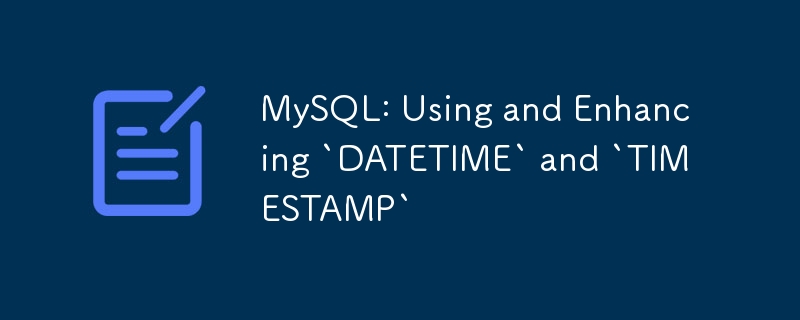

In MySQL, DATETIME and TIMESTAMP are commonly used data types for storing temporal values. Although both serve the purpose of storing date and time, there are fundamental differences between them that affect their usage. This article will explore the differences between DATETIME and TIMESTAMP, and how to overcome some limitations of DATETIME to leverage the advantages of TIMESTAMP.
To overcome some limitations of the DATETIME data type, you can follow these strategies:
To solve the issue of DATETIME not adhering to the time zone, you can standardize all temporal operations at the database and application level to use UTC.
SET GLOBAL time_zone = '+00:00'; SET time_zone = '+00:00';
INSERT INTO example_table (event_time) VALUES (CONVERT_TZ('2024-06-19 12:30:00', 'Your/Timezone', '+00:00'));
SELECT CONVERT_TZ(event_time, '+00:00', 'Your/Timezone') as local_event_time FROM example_table;
To automatically update DATETIME values when a row is modified, you can use triggers.
CREATE TRIGGER before_update_example_table BEFORE UPDATE ON example_table FOR EACH ROW BEGIN SET NEW.updated_at = NOW(); END;
To set DATETIME values automatically on insertion, you can assign default values using the NOW() function.
CREATE TABLE example_table (
id INT PRIMARY KEY AUTO_INCREMENT,
created_at DATETIME DEFAULT CURRENT_TIMESTAMP,
updated_at DATETIME DEFAULT CURRENT_TIMESTAMP ON UPDATE CURRENT_TIMESTAMP
);
If higher precision for times is needed, you can use DATETIME(6) or TIMESTAMP(6) to store times up to microsecond precision.
CREATE TABLE example_table (
id INT PRIMARY KEY AUTO_INCREMENT,
created_at DATETIME(6) DEFAULT CURRENT_TIMESTAMP(6),
updated_at DATETIME(6) DEFAULT CURRENT_TIMESTAMP(6) ON UPDATE CURRENT_TIMESTAMP(6)
);
Ensure your application handles times correctly by converting all times to UTC before storing them and converting them back to local time when displaying them to the user.
// Setting the application time zone to UTC
date_default_timezone_set('UTC');
// Storing the current time as UTC
$current_time_utc = date('Y-m-d H:i:s');
$query = "INSERT INTO example_table (event_time) VALUES ('$current_time_utc')";
// Retrieving the time and converting it to local time
$event_time_utc = '2024-06-19 12:30:00';
$event_time_local = new DateTime($event_time_utc, new DateTimeZone('UTC'));
$event_time_local->setTimezone(new DateTimeZone('Your/Timezone'));
echo $event_time_local->format('Y-m-d H:i:s');
By following these strategies, you can leverage the benefits of TIMESTAMP while using DATETIME, making it easier to handle temporal values efficiently and effectively.
The above is the detailed content of MySQL: Using and Enhancing `DATETIME` and `TIMESTAMP`. For more information, please follow other related articles on the PHP Chinese website!
 How to buy and sell Bitcoin in the country
How to buy and sell Bitcoin in the country
 minidump.dmp
minidump.dmp
 What servers are there on the web?
What servers are there on the web?
 What are the applications of the Internet of Things?
What are the applications of the Internet of Things?
 How do I set up WeChat to require my consent when people add me to a group?
How do I set up WeChat to require my consent when people add me to a group?
 What to do if the chm file cannot be opened
What to do if the chm file cannot be opened
 NTSD command usage
NTSD command usage
 Computer software systems include
Computer software systems include




